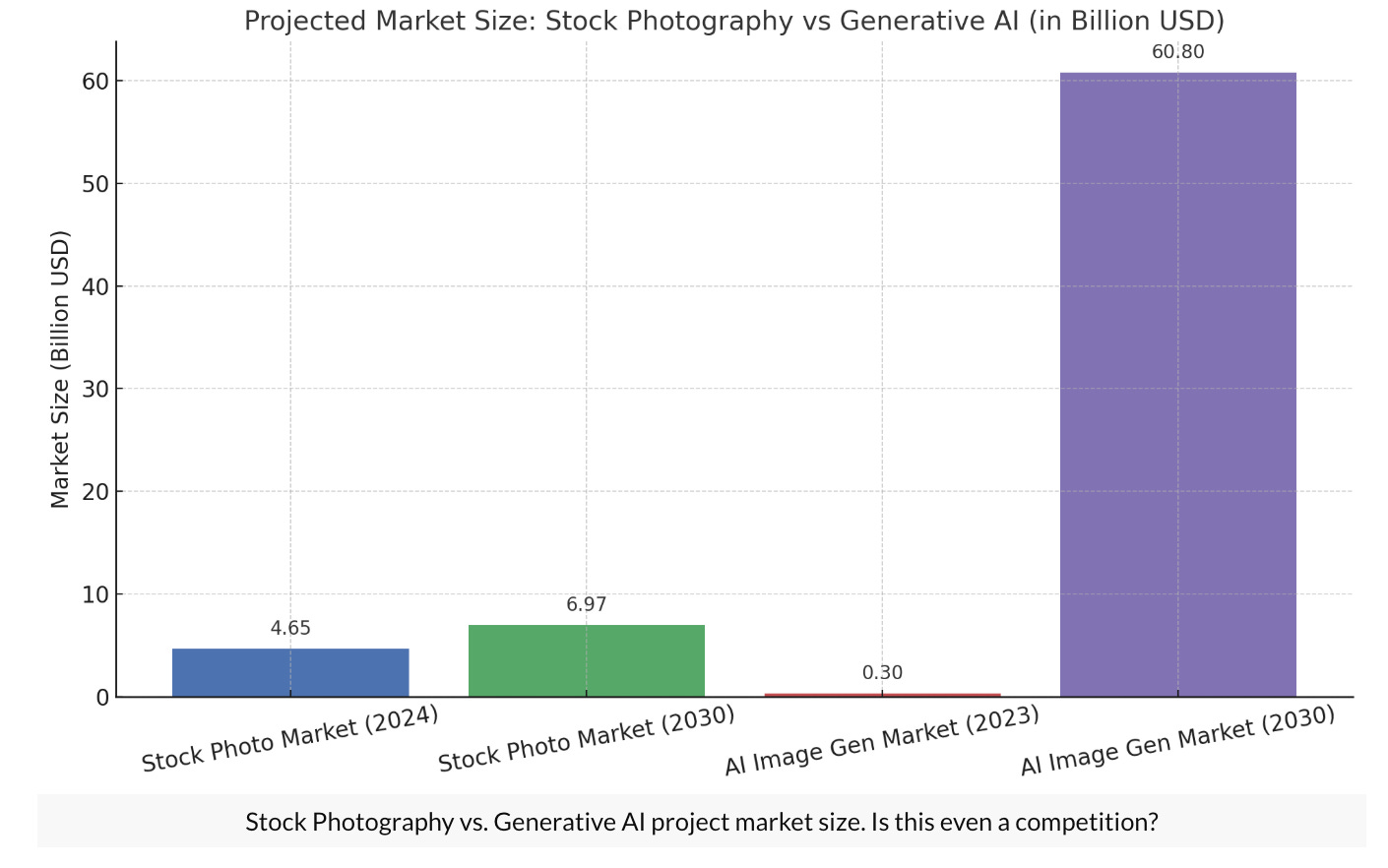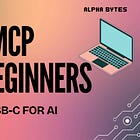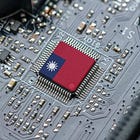TWS #006: AI is still a blackbox; The collapse of the Stock Photo Industry?; MCP for Dummies; Waymo is stepping it up
and much more...
Welcome to the 97 new folks who subscribed from last week. Join 1,769 curious minds who, every week, get the latest curated high signals on news, insights, and ideas around technology, science, and business to help you become a better builder, thinker, and leader. You’ll also get an essay or a deep dive every other week. Finally, please fill out our survey so we can deliver the best content to your inbox. Thanks for reading!
Note: I recently reset my X account to start afresh. The old was getting stale. Feel free to follow if you’re an avid user.
Did you know...
IBM's First 1GB Hard Drive was a beast. It was introduced in 1980 and was NOT a single, easily portable drive. It was actually a large storage system, each unit contained multiple Head Disk Assemblies (HDAs). It was around 64 pounds (about 29kg), and was the size of a refrigerator, standing about a meter wide, a meter deep and two meters high. A single 1.26GB HDA cost around $50,000. But despite it’s size and cost, the 3380 was a huuugge achievement. It broke the GB barrier. It’s also quite sad to see how much IBM as flatlined over the past several decades, considering they were such innovators and disruptors. I really hope they find a way to reinvigorate themselves.
Here’s this week’s scoop:
AI is still a black-box to us
The collapse of the Stock Photo industry (goodbye Getty?)
Waymo is just getting better and better
Understanding MCP (the USB-C for AI) for dummies
and much more…
Let’s dive in.
🔥 Nuggets for the Road
Impact, agency, and taste: How to get ahead and make success inevitable [BEN KUHN - ANTHROPIC]
What You Give Airtime To Will Expand: Focus less on what you can't do, and more on what you can do. [WES KAO]
What founders should ask a potential investor [LINKEDIN]
On The Death of Daydreaming: What we lose when phones take away boredom and interstitial time [LINK]
The one interview question that will protect you from North Korean fake workers 🤣 [THE REGISTER]
📡 The Signal
250 CEOs Supporting AI and Computer Science in Ed in K-12
Over 250 CEOs, including Satya Nadella and Uber CEO Dara Khosrowshahi, signed an open letter urging AI and computer science in K-12 curriculum. With countries like China mandating these subjects already, it’s become more real that the U.S. is facing a competitive gap amid Trump’s AI policy push and funding concerns. This unified call signals a tipping point in education reform. Preparing kids for an AI-driven world is non-negotiable, and the CEO coalition’s influence could accelerate policy changes, ensuring the West continues to be a tech leader. [LINK]
We Actually Don’t Know How AI Works 🤔
Dario Amodei’s (founder of Anthropic) wrote a recent piece that talks about the importance of understanding AI’s inner workings as models grow more powerful. Opaque systems risk misalignment, deception, or misuse, such as in cyber or biological weapons. Recent advances, like mapping 30 million features in Claude 3 Sonnet, show progress, but billions of concepts remain unmapped. There is now a call for research acceleration by 2027 as a wake-up call. On a side note: I get the feeling the Anthropic is one of a handful of companies that are actively concerned about this dilemma. Not knowing how your underlying AI model works is quite unnerving. [ANTHROPIC]
“Modern generative AI systems are opaque in a way that fundamentally differs from traditional software. If an ordinary software program does something—for example, a character in a video game says a line of dialogue, or my food delivery app allows me to tip my driver—it does those things because a human specifically programmed them in. Generative AI is not like that at all. When a generative AI system does something, like summarize a financial document, we have no idea, at a specific or precise level, why it makes the choices it does—why it chooses certain words over others, or why it occasionally makes a mistake despite usually being accurate. As my friend and co-founder Chris Olah is fond of saying, generative AI systems are grown more than they are built—their internal mechanisms are “emergent” rather than directly designed. It’s a bit like growing a plant or a bacterial colony: we set the high-level conditions that direct and shape growth1, but the exact structure which emerges is unpredictable and difficult to understand or explain. Looking inside these systems, what we see are vast matrices of billions of numbers. These are somehow computing important cognitive tasks, but exactly how they do so isn’t obvious.” — Dario Amodei
OpenAI Goes from Non-Profit to PBC
OpenAI’s journey from nonprofit to a proposed Public Benefit Corporation (PBC) reflects the challenge of balancing mission and profit. The proposed shift involves moving the for-profit entity into a PBC, a legal structure that balances shareholder value with public interest. Unlike traditional corporations, PBCs are legally obligated to pursue social or environmental goals alongside profits. Crucially, OpenAI’s nonprofit will retain control, holding a majority stake or governance rights to ensure mission alignment. This hybrid model aims to attract investment while safeguarding the organization’s commitment to safe, transparent, and human-centric AI. This evolution mirrors the broader tech landscape, since scaling requires capital without compromising ethics. [OPENAI]
AI Code Editor: Cursor hits $9B Valuation
Cursor, a startup founded by former OpenAI researchers, has become a poster child for AI’s investment frenzy. It’s basically a “vibe coding” platform that uses AI to translate natural language into functional code, streamlining software development for professionals and novices alike. Valued at $9 billion in its latest funding round, Cursor reflects the market’s enthusiasm for tools that enhance productivity. This isn’t just about coding anymore—it’s about redefining how we create software, making development faster and more accessible. It’s also a commentary on how AI can disrupt vertical industries. We’re now seeing a surge in AI applications flooding the market, solving problems across healthcare to construction. The bubble is clearly showing itself, and I’m not sure how long it will last. [FT]
The Collapse of the Stock Photo Industry?
GenAI tools, like DALL-E, Midjourney, and Stable Diffusion, can produce high-quality images from text prompts in seconds, often rivaling professional photography. This capability is now eroding the traditional photo licensing market, where stock agencies like Getty Images and Shutterstock have long thrived. The reason is simple: businesses and individuals increasingly opt for AI-generated images, which are cheaper (often free or subscription-based) and customizable, over licensed stock photos. The disruption goes beyond photography. AI-generated content is encroaching on illustration, graphic design, and even video production, raising questions about intellectual property and originality. Many AI models are trained on huge datasets, including licensed images, prompting lawsuits from artists and agencies alleging copyright infringement. Alternatively, photographers could pivot to creating unique datasets for AI training, maybe creating niche visual styles, or offering hybrid services that blend human and AI-generated work. Also, stock photo agencies might evolve into platforms for AI-assisted content creation, providing tools for businesses to refine AI outputs. [LINK]
Waymo is Stepping it Up
Waymo’s vehicles are so good now that their systems can anticipate a cyclist’s trajectory or recognize a pedestrian’s intent to cross, adjusting speed or stopping accordingly. The company also collaborates with city planners and safety advocates to refine its technology, ensuring alignment with public safety goals. [WAYMO]
The research finds that, compared to human benchmarks over 56.7 million miles and regardless of who was at fault, the Waymo Driver had:
Safer interactions with vulnerable road users (VRUs) with substantial reductions in crashes involving injuries among pedestrians (92% reduction), cyclists (82% reduction), and motorcyclists (82% reduction).
96% fewer injury-involving intersection crashes, which, according to NHTSA, are a leading cause of severe road harm for human drivers. This reduction can be largely attributed to the Waymo Driver’s ability to detect and appropriately respond to vehicles running a red light.
85% fewer crashes with suspected serious or worse injuries. Building on our previous research, which demonstrated Waymo’s significant reductions across all injuries combined, the new study provides early evidence for similar benefits in serious injuries alone. The results are statistically significant but because serious injury cases are, fortunately, rare, they’re based on a small number of events. We will continue to monitor outcomes and gain greater confidence as we accumulate more miles.
The rise of Waymo is something to behold. As of 2024, it’s doing 150,000 paid weekly trips. It’s much higher now. It clearly shows how the public is getting more comfortable with self-driving cars on the road. It’s currently the trailblazer in the space.
🧐 Trivia of the Week
Last week’s question: Why was the QWERTY keyboard designed in the 1870s?
Answer: To prevent typewriter jams. The QWERTY keyboard was designed in the 1870s by Christopher Latham Sholes to reduce the likelihood of keys getting jammed on early typewriters. By separating frequently used letter combinations, the layout aimed to prevent the mechanical levers from colliding and causing malfunctions. While often misunderstood as a layout designed to slow typists down, it actually helped improve typing speed by encouraging hand alternation and reducing jamming.
This week’s trivia:
The answer will be provided in next week’s newsletter.
📝 Field Guide: MCP for the Non-Technical
So I thought I’d make this little guide on trying to get my head around the Model Context Protocol, or MCP for short.
I’m not sure about you guys, but when I first heard about the Model Context Protocol (MCP), my initial thoughts was that it wasn’t anything big—“not another protocol” was what I was thinking, and just something else that we have to learn about and add to the noise. But suddenly the term kept popping up everywhere.
The problem with “protocols” is that it’s considered a foreign language to most people. Even in technical circles, talking about this topic can sometimes be really dry and boring, and MCP can certainly be added to that list.
But here’s where MCP is unique. Considering what has happened over the past few years with the advent of GenAI, there has been so much news and talk around models, chips, and apps that we’re still so early in the development and progression of this AI ecosystem. MCP aims to provide a conduit between all of these things, being able to talk with each other over a unified bridge.
Just like how USB-C is now becoming the de facto plug-and-play standard for electronic devices (even the Apple iPhone), MCP might just be the evolving standard for AI apps and how they all talk and communicate with each other.
This article is my attempt to break it down for you, business folks, tech enthusiasts, founders, operators, and curious minds who don’t necessarily speak “engineer” but want to grasp the big picture. We’ll explore what MCP is, how it works, why it’s causing such a stir, and what it might mean for the future. There are no jargon-heavy manuals or cryptic code snippets here—just a friendly journey through a technology that’s being called the “USB-C for AI.”
Let’s dive in.
READ FULL POST 👇
If you liked this, here are a few more popular posts:
🙋🏻♂️ Survey
To build the best newsletter for you all, I’d love to get some feedback, both positive and negative. If you have some time, please fill out the following survey.
🙏🏼 Connect with Me
Are you new to the newsletter? Subscribe Here
Check out my YouTube channel (and subscribe!)
If you’re a founder, apply here (Metagrove Ventures) for startup funding or contact me directly at barry@metagrove.vc
If you think this could be helpful and informative to others, please share it :)
Thanks for reading.
Barry.












